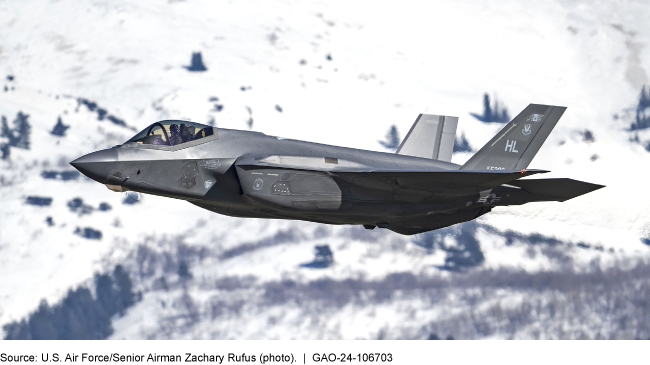F-35 Sustainment: Costs Continue to Rise While Planned Use and Availability Have Decreased
Fast Facts
The F-35 aircraft is DOD's most advanced and costly weapon system. DOD currently has about 630 F-35s, plans to buy about 1,800 more, and intends to use them through 2088.
We reported in this Q&A that DOD's projected costs to sustain the F-35 fleet keep increasing—from $1.1 trillion in 2018 to $1.58 trillion in 2023. Yet DOD plans to fly the F-35 less than originally estimated, partly because of reliability issues with the aircraft. The F-35's ability to perform its mission has also trended downward over the past 5 years.
We've made 43 recommendations to improve the F-35 program in recent years. DOD has yet to implement 30 of them.
The F-35 Aircraft

Highlights
What GAO Found
The F-35 Lightning II aircraft (F-35) is the Department of Defense's (DOD) most ambitious and costly weapon system and its most advanced fighter aircraft. DOD operates and sustains about 630 F-35 aircraft and plans to buy about 2,500 total by the mid-2040s with a projected planned life into the 2080s.
However, DOD's projected costs for sustaining the F-35 continue to increase while planned use of the aircraft declines. Specifically:
- Sustainment cost estimates have increased 44 percent, from $1.1 trillion in 2018 to $1.58 trillion in 2023.
- DOD's planned use of the F-35 and its availability have decreased. The Air Force, Navy, and Marine Corps project they will fly the F-35 less than originally estimated on an annual basis. The F-35 fleet's overall availability has trended downward considerably over the past 5 years, and none of the variants of the aircraft (i.e., the F-35A, F-35B, and F-35C) are meeting availability goals.
- The Air Force, Navy, and Marine Corps' have made progress in meeting their affordability targets (i.e., the amount of money they project they can afford to spend per aircraft per year for operating the aircraft). This is due in part to the reduction in planned flight hours, and because the Air Force increased the amount of money it projects it can afford to spend. DOD currently estimates the Air Force will pay $6.6 million annually to operate and sustain an individual aircraft. This continues to be well above the $4.1 million original target. In June 2023, the Air Force increased the amount of money it can afford to spend per F-35 aircraft to $6.8 million per year.
- DOD has pursued cost savings efforts and continues to look for new ways to reduce costs. However, DOD officials generally agree that these efforts are not likely to fundamentally change the estimated costs to operate the aircraft.
Why GAO Did This Study
DOD plans to use the F-35 aircraft through 2088 and plans to spend over $2 trillion on acquisition and sustainment. The National Defense Authorization Act for Fiscal Year 2022 includes a provision for GAO to conduct an annual review of F-35 sustainment efforts, including DOD's ability to reduce sustainment costs, or otherwise maintain the affordability of the F-35 fleet. This report provides information on the F-35's sustainment cost estimates over the life of the program, actions taken by the F-35 Joint Program Office to reduce sustainment costs, and the extent to which the F-35 fleet has met performance goals. GAO analyzed DOD's F-35 sustainment cost estimates and performance data and interviewed cognizant DOD officials about these issues.
Recommendations
Since 2014, GAO has made 43 recommendations designed to improve the department's operation and sustainment of the F-35 program. While DOD concurred with many of these recommendations and has implemented some of them, 30 (about 70 percent) remain unimplemented. For example, DOD has not implemented GAO's recommendations that it update the sustainment strategy for the F-35 engine, improve the program's management of spare parts, and reassess government and contractor responsibility for different aspects of F-35 sustainment.
